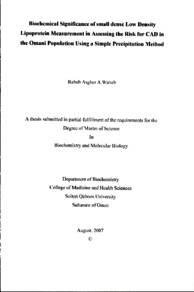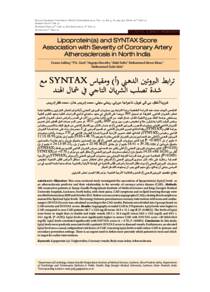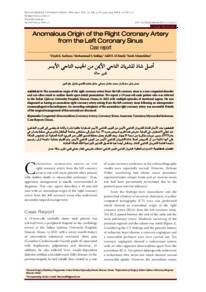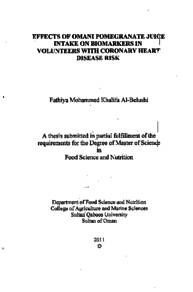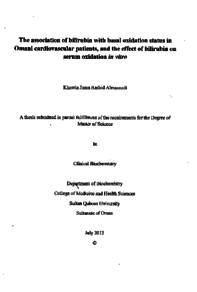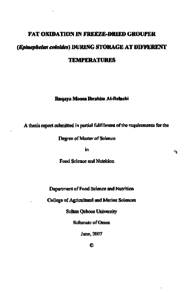Document
Biochemical significance of small dense low density lipoprotein measurement in assessing the risk for CAD in the Omani population using a simple precipitation method
Publisher
Sultan Qaboos University
Gregorian
2007
Language
English
Subject
English abstract
recognized to correlate with increased triglycerides (TGs), and low HDL-cholesterol (HDL-C). Indeed, it is known that the TG concentration is inversely associated with LDL size.Methods for measurement of sd LDL concentration are too laborious for clinical use. A new technique was recently established to quantify sd LDL concentration. It is a simple precipitation method consisting of two steps: first, to precipitate the lipoproteins (density (d) = 1.044 to 1.063 g/ml) using heparin-magnesium; and second, to measure LDL cholesterol in the supernatant using automated clinical chemistry analyzer.The aim of this study was to measure sd LDL concentration in Omani subjects with different lipid profiles, particularly subjects with high and normal TG levels. The accuracy of this method was verified by measuring LDL size using the conventional method; Polyacrylamide Gradient Gel Electrophoresis (PAGGE).132 serum samples were collected from normolipidemic and dyslipidemic Omani men and women. The subjects were categorized according to their serum triglyceride levels. LDL cholesterol, HDL cholesterol, apoprotein B, apopreotein A-1 and glucose were also measured.Using the precipitation method, we found that subjects with hypertriglyceridemia (TG > 1.7 mmole/L or TG/HDL > 0.9) had a significantly higher concentration of sd LDL than subjects with normal TG levels. Bivariate correlation analysis, in general, showed a significant positive correlation between TG levels and sd LDL concentration (r = 0.395, p<0.0001), which was higher than the correlation of TG levels with conventionally measured LDL-C.This was coherent with our findings using PAGGE where TG levels negatively correlated with size of LDL in our subjects (r = -0.432, p<0.0001) and in fact, stepwise multiple regression showed that TG levels, regardless of LDL-C concentration, were the only significant determinant of LDL size (- -1.46. p<0.0001). Furthermore, a significant negative correlation was found between LDL size and concentration of sd LDL determined using the precipitation method (r = . 0.207, p<0.05).These results underline the importance of increased TG levels in serum, as the increase in TG levels alone in serum even without an increase in LDL-C levels is associated with increased sd LDL concentration and decreased LDL size which are major CAD risk factors.This simple precipitation method may be useful and applicable to obtain a direct estimate of sd LDL concentration created due to increased TG levels in serum. Therefore, the results also suggest that TG levels should not be overlooked as a major risk factor for CAD and measuring TG levels may be a valuable inexpensive screening tool to identify patients at risk of CAD due to increased sd LDL-C.
Description
Thesis
Member of
Resource URL
Arabic abstract
مؤخرا سلط الضوء على نوع من البروتينات الدهنية منخفضة الكثافة (sd LDL-C ) كعامل خطر أساسي اللاصابة بأمراض القلب التاجية (CAD). حاليا يعتبر غلية هذه البروتينات الدهنية منخفضة الكثافة في الدم مرتبط بارتفاع مستوى الدهنيات الثلاثية (Triglyceride ) وانخفاض مستوى البروتينات الدهنية عالية الكثافة ( HDL - C ). ومن المعروف أن تركيز الدهنيات الثلاثية يرتبط ارتباطا عكسيا مع حجم sd LDLأساليب قياس تركيز sd LDL شاقة جدا للاستعمال السريري. مؤخرا تم انشاء تقنية جديدة لقياس تركيز sd LDL - C . وهذه التقنية عبارة عن طريقة ترسيب بسيطة تتكون من خطوتين : الأولى ، ترسيب البروتينات الدهنية (الكثافة = 1, 044 - 1 . 063 غرام / مليلتر) باستخدام الهيبارين و المغنيزيوم ؛ وثانيا ، قياس الكولسترول في ال sd LDL باستخدام جهاز التحليل الآلي في مختبرات الكيمياء السريرية والهدف من هذه الدراسة هو قياس تركيز sd LDL - C في المجتمع العماني بمختلف مستويات الدهون لديهم، وخصوصا في الأشخاص الذين لديهم معدلات طبيعية و مرتفعة من الدهنيات الثلاثية. تم التحقق من دقة هذه الطريقة بقياس حجم sd LDL - C باستخدام الطريقة التقليدية (PAGGE).تم تجميع 132 عينة دم (مصل) من العمانيين الذين لديهم مستويات طبيعية من الدهون (Normolipidemic) ومستويات مرتفعة من الدهون (Dyslipidemic) من كلا الجنسين. ثم تم تصنيف العينات وفقا لمستويات الدهنيات الثلاثية ليهم (Triglyceride). كما تم ايضا قياس البروتينات الدهنية منخفضة الكثافة ( LDL C )، البروتينات الدهنية مرتفعة الكثافة ( HDL - C )، البروتينات الدهنية (100- apo- AI & apoB ) والجلوكوز. عند استخدام طريقة الترسيب البسيطة، وجدنا أن الأشخاص الذين يعانون من ارتفاع في مستويات الدهنيات الثلاثية (TG > 1 . 7 mmole / L و 0 . 9 < TG / HD ) لديهم ارتفاع في تركيز sd LDL مقارنة بالأشخاص الطبيعيين. و بصورة عامة، احصائيا وجدنا أن مستويات الدهنيات الثلاثية مرتبطة بعلاقة طردية قوية مع مستويات تركيز أr = 0 . 395 , p < 0 . 0001 ) sd LDL – C وهي أعلى من مستويات الربط مع LDL- C وهذا أمر يتفق مع النتائج التي توصلنا اليها باستخدام PAGGE حيث أن مستويات الدهنيات الثلاثية ارتبط عكسيا مع حجم r = - 0 . 432 . p < 0 . 0001 ) ) LDL - C)، وايضا تبين من النتائج أن مستويات الدهنيات الثلاثية كان الوحيد الذي يعتد به في تحديد حجم p < 0 . 0001 ) LDL , 1 . 46 -=)) ، بصرف النظر عن تركيز LDL - C . وعلاوة على ذلك ، وجدنا ارتباطا عكسيا كبيرا بين حجم LDL وتركيز sd LDL الذي تم قياسه باستخدام طريقة الترسيب البسيطة ( 0. 05> r= - 0 . 207 , p ) هذه النتائج تؤكد اهمية زيادة مستويات الدهنيات الثلاثية في المصل ، لأن الزياده في مستويات TG مرتبطة مع ارتفاع في تركيز sd LDL و تراجع حجم LDL اللتين تعتبران من العوامل الخطرة الرئيسية في الأصابة بأمراض القلب التاجيةتعتبر طريقة الترسيب بسيطة يمكن الاستفادة منها وتطبيقها للحصول مباشرة على تركيز sd LDL نتيجة لزيادة مستويات الدهنيات الثلاثية في المصل لذلك ، فان النتائج تشير ايضا الى ان مستويات TG لا يمكن تجاهلها باعتبارها عامل خطر رئيسي للأصابة بأمراض القلب التاجية ، و قياس مستويات TG قد تكون أداة فحص قيمة و غير مكلفة لتحديد المرضى المعرضين لخطر الإصابة بأمراض القلب التاجية، بسبب زيادة تركيز sd LDL
Category
Theses and Dissertations

